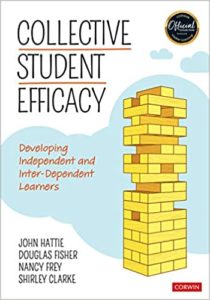Develop Independent and Inter-Dependent Learners
Collective Student Efficacy: Developing Independent and Inter-Dependent Learners
By John Hattie, Douglas Fisher, Nancy Frey and Shirley Clarke
(Corwin Press, 2021 – Learn more)
Reviewed by Sarah Cooper

This book is almost jaw-droppingly research based, with analyses and meta-analyses supporting dozens of assertions, diagrams and charts. It also includes “Learning from a Distance” insets for those teachers who need to connect virtually.

In an ideal group situation, committed teachers can “build collective confidence in their joint capabilities to make a difference,” leading to positive outcomes for themselves and their students.
What collective student efficacy is not
The authors are careful to note that “collective student efficiency” is “NOT…collaborative grouping, cooperative learning, or merely rearranging desks such that students sit in groups. We are not talking about students working toward a common goal or working on different parts of a problem and simply piecing the solutions together.”
Instead, with collective efficacy, the group product is consistently more complex than what students could achieve on their own.
To ensure this kind of high-level work, students need to have “I” skills, such as self-awareness, self-regulation and appropriate self-confidence, as well as “we” skills, including social sensitivity and “potency” – the sense that “our team will be successful no matter what the task.” One important thesis of this book is that these skills can be taught.
The chapters are well constructed to provide the why, what and how of collective efficacy:
- Introduction: Why Collective Efficacy?
- Chapter 1: The Value of the Collective
- Chapter 2: Why Focus on Collective Student Efficacy?
- Chapter 3: Developing the “I” Skills
- Chapter 4: Developing the “We” Skills
- Chapter 5: The Learning Design of the Lesson
- Chapter 6: Learning Intentions and Student Criteria for Collective Student Efficacy
- Chapter 7: Learning in Pairs and Groups
- Chapter 8: Assessment of Collective Student Efficacy
- Chapter 9: The Possibility of Collective Student Efficacy
A few of the nuggets to try
Throughout, I found myself having aha moments that I wanted to apply to my classes this year. Here are just a handful of examples:
Build knowledge before group work:
“Too often, not attending to the students’ knowledge building before they venture into group work is the major barrier to the success of the collective…. For example, the effect-size of PBL increases from .15 to .50 when it is established that the students have sufficient background knowledge to move to the PBL phase.”
In addition, “there are optimal times for students to work collectively. In most cases, the optimal time for collective work is after they have acquired and consolidated surface-level knowledge.”
Take turns as part of social sensitivity:
“Turn-taking in a group is very important. It turns out that many aspects of turn-taking, such as timing, are remarkably stable across languages and cultures. It involves anticipating the other person’s pauses, avoiding overlap, minimizing silences between turns, sometimes ignoring the other and merely waiting to reenter the conversation, and sometimes flowing from the other’s turn.”
Create tasks to encourage meaningful group work:
Tasks “have an appropriate challenge and motivation factor so that more than one thinker is required and there is enthusiasm to work together to solve a particular problem,” “are more open than closed to allow for multiple interpretations,” and “are built so that errors and mistakes are seen as opportunities for all to learn and able to be attended to without shame,” to name a few.
Call it formative evaluation, not formative assessment:
The term formative evaluation “privileges the many sources of evidence and the importance of ‘interpretation’ of this evidence” by students and teachers.
Change desk partners frequently:
After working with hundreds of teachers, the authors “determined the optimum time for changing partners at about one week for elementary students, and after every sixth lesson for secondary students.” I’m going to try this immediately with my 8th grade civics classes!
Changes I look forward to implementing
After reading Collective Student Efficacy, I am newly inspired to brainstorm meaningful tasks that require complex, interdependent group work, and to scaffold them appropriately with “I” and “we” skills.
Beyond that practical application, I now will see all group work anew, whether it’s in the classroom with students or in a professional learning community with other teachers. I want to look at groups through the lens not simply of collaboration but of potency, of believing that the group has the power to succeed and be better together than we are on our own.
Read another review of Collective Student Efficacy by Helene Alalouf
Sarah J. Cooper (@sarahjcooper01) teaches eighth-grade civics and U.S. history and is Associate Head of School at Flintridge Preparatory School in La Canada, California, where she has also taught English Language Arts.
Sarah is the author of Making History Mine (Stenhouse, 2009) and Creating Citizens: Teaching Civics and Current Events in the History Classroom (Routledge, 2017). She presents at conferences and writes for a variety of educational sites, including MiddleWeb. You can find all of Sarah’s writing at sarahjcooper.com.




































